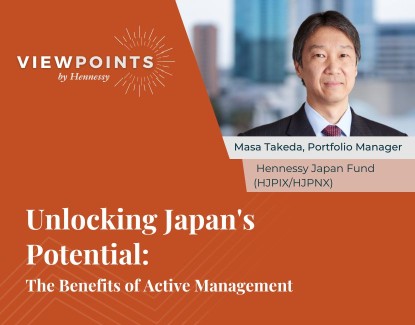Market Commentary and Fund Performance
Masa Takeda of Tokyo-based SPARX Asset Management Co., Ltd., sub-advisor to the Hennessy Japan Fund, shares his insights on the Japanese market and Fund performance.
-
 Masakazu Takeda, CFA, CMAPortfolio Manager
Masakazu Takeda, CFA, CMAPortfolio Manager
Performance data quoted represents past performance; past performance does not guarantee future results. The investment return and principal value of an investment will fluctuate so that an investor’s shares, when redeemed, may be worth more or less than their original cost. Current performance of the fund may be lower or higher than the performance quoted. Performance data current to the most recent month end, and standardized performance can be obtained by viewing the fact sheet or by clicking here.
Fund Performance Review
In August, the Fund decreased by 1.71% (HJPIX), outperforming its benchmark, the Russell/Nomura Total Market Index, which fell by 2.27%.
The month’s positive performers among the Global Industry Classification Standard (GICS) sectors included shares of Consumer Staples and Communication Services while Health Care and Information Technology detracted from the Fund’s performance.
Click here for full, standardized Fund performance.
Among the best performers were our investments in Rohto Pharmaceutical, a leading skincare cosmetics and over-the-counter ophthalmic medicines producer, Hitachi, Ltd., one of Japan’s oldest electric equipment and heavy industrial machinery manufacturers, and ASICS Corporation, the high performance running shoes maker.
As for the laggards, Sony Group Corporation, a diversified consumer and professional electronics, gaming, entertainment and financial services conglomerate, Olympus Corporation, the leading company in the medical field such as gastrointestinal endoscopy, which has a 70% share of the world market, and Daikin Industries, Ltd., the leading global manufacturer of commercial-use air conditioners, were the largest detractors.
We are currently investing in all three Japanese mega general insurance groups.
Before we revisit the attractiveness of their businesses in this letter, we would like to briefly touch on two recent issues that have been making headlines: 1) the suspected policy price-fixing practice in the corporate fire insurance (co-insurance business) and 2) the fraudulent insurance claims issue involving Bigmotor Co., a domestic car repair shop chain which was also an insurance agent for the insurers.
Regarding the first issue, there is a concern that if the co-insurance business has been artificially raising prices and generating excessive profits, the business could face backlash in the wake of this issue. However, in our opinion, this will not be the case. The corporate fire insurance business has been loss-making for many years for the whole industry.
As such, efforts have been made to improve profitability through premium increases since 2019. The insurance business plays an important role in covering damages that policyholders cannot bear alone by pooling the insurance needs of a large number of customers. If the business cannot turn profitable, it could lead to a decrease in the underwriting capacity, undermining the societal good contributed by them. We are of the view that the trend of premium increases will remain on track.
As for the second point, it seems unlikely that insurance companies conspired with them to commit fraudulent claims. Also, the criticism that this issue has indirectly inflated the premiums of the entire auto insurance industry we feel is overstated given the small number of vehicles involved in the allegation.
In both cases, there are indeed many voices questioning the lack of proper oversight, and as a result, the public image of insurance companies has been tarnished. However, we believe the governance system will be strengthened significantly going forward. Meanwhile, the overall fundamentals of the industry will not be impacted greatly, from our perspective.
General Insurance Compared to Banks and Asset Management
As a business model, insurance companies receive premiums and in return, compensate for the cost of damages such as repairs in the event of a car accident or fire on behalf of the policyholder. The insurer earns profit by investing the premiums received until the insurance money is paid out. If no insurance claim occurs or the actual payout is less than the received premium, the insurer can pocket the difference. Thus, the main sources of revenue consist of investment income and underwriting income.
Insurance companies, banks, and asset management companies are all similar in that they generate revenue by utilizing external funds. But each one of these businesses has different characteristics. For instance, banks collect deposits and lend them out to earn “spread.” Since the deposit belongs to the depositor, from the bank’s perspective, it is “borrowing” from the outside. The interest paid to depositors is the bank’s “fundraising cost.” On the other hand, if the claim payment by an insurance company exceeds the received premium, the difference is effectively the “fundraising cost” (i.e. insurance underwriting loss). In the case of profitable insurance underwriting, the business incurs no fundraising cost, better yet the insurer gets “paid” to raise funds from policyholders. Therefore, we consider an insurance company with a profitable underwriting business more attractive than banks.
Asset management companies receive funds from investors and earn management fees for their investment services. This is akin to a profitable insurance underwriting. However, unlike the insurance business where the returns gained from investing insurance premiums become the insurer’s profits, the investment gains generated by an asset management company belong to the customers. This is another reason why we regard the insurance business as more attractive. That is, an insurance company that can record a profit in underwriting and achieve high returns on investment qualifies as a great business.
General Insurance Compared to Life Insurance
What about the difference between general insurance and life insurance? One of the positive aspects of the life insurance business is the stable underwriting profits. This comes from the difference between the assumed mortality rate used in the premium calculation and the actual mortality rate, which fluctuates less than the occurrence of loss events in property and casualty insurance. Furthermore, life insurance contracts generally last for several decades, and the expected insurance payouts are fixed in the contract, so even in an inflationary environment, the burden on the insurance company does not increase (the insurer can pay off with depreciated dollars). In contrast, payouts by general insurance can go up with inflation in the form of rising automobile repair costs, etc.
A disadvantage of the life insurance business is when long-term interest rates are low, it typically does not enjoy high returns on capital. In this respect, general insurance companies are preferable because their contract periods are generally short-term. They can expect their operating profits to improve at an early stage of rising interest rates. As we discuss below, general insurance can lower business risks through overseas expansion, which in turn should reduce equity risk premiums.
Overseas Expansion by Japanese General Insurers Makes a Lot of Sense
Today, Japanese banks, general insurers, and life insurers are all proactive in expanding overseas to increase scale. In our view, overseas expansion by general insurance makes the most sense due to the nature of its business. The domestic underwriting business of Japanese general insurers is dominated by automobile and fire insurance, and the risk of natural disasters is concentrated in typhoons and earthquakes. However, not all countries are like Japan. In particular, the U.S. is a huge market with a wide range of insurance fields. In addition to the mainstay auto and property insurance, other subsets of the industry like D&O insurance (directors and officers liability insurance), workers’ compensation insurance, group health insurance, cyber insurance, and other special insurance markets are also well-established. Japanese general insurance companies can diversify their underwriting risks by entering these markets or through acquisitions. From an equity valuation perspective, this should theoretically lower equity risk premiums, translating into higher valuation multiples over time.
Japan’s mega-banks are also focusing on the U.S. and Asia, but interest rate movements, which have a major impact on lending operations, tend to move in the same direction globally. For example, if interest rates rise in the U.S. due to rising inflation, it leads to a stronger dollar. This causes inflation in other countries through rising import prices, which puts upward pressure on their local interest rates. In other words, overseas expansion is not necessarily a good strategy when it comes to diversifying interest rate risks.
As for the life insurance business, insurance contracts are much more granular than non-life contracts with policyholders made up of a large number of individuals. For this reason, sufficient diversification is already achieved within its home market itself, and expanding overseas does not contribute all that much to the diversification of the mortality risks.
The Competitive Edge of Japanese General Insurers
We feel Japanese general insurers are uniquely positioned in the global insurance industry. As explained in our June 2022 letter, the competitive advantages of the Japanese general insurance industry are two-fold: 1) high profitability and abundant profits generated in the domestic market owing to its oligopolistic state, and 2) the existence of “policy shareholdings” which have large unrealized gains.1
Regarding the former, the domestic general insurance industry has consolidated after the so-called Japan’s “Big Bang” financial system reforms in the 1990s. Today it is dominated by three mega insurance groups, namely Tokyo Marine Holdings, MS&AD Insurance Group Holdings, and SOMPO Holdings (with a total market share of 90%). To our knowledge, there is no other insurance market in the world as concentrated as Japan. For example, in the U.S., over 50 companies operate in auto insurance alone as of 2020 with the largest company having only a 16% market share,1 making the competitive landscape far more intense.
On “policy shareholdings,” the insurers purchased these shares in the 1960s to build and maintain business relationships in corporate insurance, worth between 1.2 and 2.4 trillion yen ($8.1 billion and $16.2 billion) in market value as of the end of March 2023.2 Despite the unrealized gains, these equity holdings have been viewed as “under-utilized assets” for a long time, leading them to liquidate about 100-150 billion yen’s ($676 million - $1.0 billion) worth each year as a war chest. This is the other unique aspect of Japanese general insurers that cannot be observed elsewhere.
Good Capital Allocators
We believe that the management of all three listed mega-insurance groups is practicing exemplary capital allocation. In other words, each company is wisely using the abundant domestic profits as well as the proceeds from the sales of policy shareholdings in various ways to increase shareholder value.
One of these ways is overseas mergers and acquisitions (M&A). For example, Tokio Marine Holdings has been strengthening its overseas business for nearly 20 years. Particularly since 2008, the company has been actively acquiring businesses. As of the March 2023 fiscal year, around 45% of consolidated net insurance premium income and underwriting profit were generated by overseas operations.
When no strong M&A candidates are found, the insurers actively return profits to their shareholders. Particularly in situations where the stock is undervalued, continuous share buybacks and dividend increases can be powerful tools. In share buybacks, the more undervalued the stock is, the more shares can be bought, resulting in higher earnings per share for shareholders. Especially in the case of MS&AD and SOMPO whose share prices are at price to book ratio (P/B) less than 1 time, these actions increase the per share book value. We like the fact that the management has the financial flexibility to improve return on equity (ROE) by suppressing unnecessary increases in shareholders’ capital through these measures.
Stock Valuation
Lastly, let us shed some light on the valuations. The three stocks all look cheap to us.
Firstly for Tokyo Marine, management is guiding for adjusted net profit for the fiscal year ending March 2024 of 670 billion yen ($4.5 billion) with adjusted net assets expected to be 3,926 billion yen ($26.6 billion). The adjusted net profit used by the Japanese insurance companies as a key performance indicator (KPI) is a metric adjusted for “provision for catastrophe loss reserves” and “provision for price fluctuation reserves” (which are mandatory under J-GAAP), making them comparable to International Financial Reporting Standards (IFRS)-compliant foreign peers. Based on this, the current stock valuation is approximately 9x price to earnings ratio (P/E), 1.6x P/B and a dividend yield of 4%. Over the past decade, Tokio Marine has achieved an average annual growth rate higher than that of Chubb (U.S.), Allianz (Germany), and AXA (France) with its adjusted ROE approaching 17%. Considering the potential to become a top-tier global insurance company in terms of profit scale and profitability, we consider the stock attractive.
Both MS&AD and SOMPO are trading below 1x P/B. Part of the reason is that the performance of their stock prices over the past seven years has not kept pace with the growth of their earnings per share (EPS), suggesting they are undervalued. From the fiscal year ending in March 2017 through the fiscal year March 2024 company forecasts, the cumulative growth rate of MS&AD’s EPS shows +82%, while the stock price growth over the same period is only +44%. For SOMPO, the EPS growth is +81% compared to a stock price growth of +57%.3 Forward P/E for both stocks based on the companies’ forecasted net profits are just 8.0x for MS&AD and 7.8x for Sompo, significantly below the Tokyo Stock Exchange average. Additionally, the dividend yields are nearly 5%, considerably above the market average.
We believe that all three companies are attractive investments as the expected returns for shareholders come out to around 10+%, calculated by adding sustainable core earnings growth (+5~7%), the increase in EPS due to buybacks (+1~2%), and the dividend yields (+4~5%).
On top of this, there is scope for re-rating the valuation multiples, which could bring a significant upside to these stocks. After seeing the sharp re-rating of general trading companies post Warren Buffett’s surprise visit to Japan and his endorsement of these securities during the first half of this year, this has become a part of our investment thesis as well.
Click here for a full listing of Holdings.
- In this article:
- Japan
- Japan Fund
1 Source: National Association of Insurance Commissioners (2021) The Top 10 Largest Auto Insurance Companies in 2022 | The Motley Fool.
2 Source: The YUHO annual securities reports.
3 The revised net profit and the number of issued shares used are from the financial results briefing materials or the integrated report of MS&AD and SOMPO for the fiscal year ending March 2017. The revised net profit for the fiscal year ending March 2024 is based on the company's forecast, and the number of issued shares is as of the end of March 2023, excluding treasury shares. The stock price is based on the stock price at the end of December for the fiscal year ending March.
You might also like
-
 Viewpoint
ViewpointJapan's Economic Transformation: Insights on Markets, Tariffs, and Active Management
 Masakazu Takeda, CFA, CMAPortfolio ManagerWatch the Video
Masakazu Takeda, CFA, CMAPortfolio ManagerWatch the VideoWith market volatility expected to persist, what are the key factors driving Japanese equities resilience? Explore the Japanese market with Masa Takeda, Portfolio Manager of the Hennessy Japan Fund. He analyzes the effects of U.S. tariffs, the yen’s movements, and the implications of Japan’s move away from deflation. Get an overview of the potential strategic investment opportunities in companies like Tokyo Marine and Orix, and gain insights into the current situation of Seven & i Holdings.
-
 Portfolio Perspective
Portfolio Perspective
Japan Small Cap FundFinding Compelling Japanese Small-Caps
 Takenari Okumura, CMAPortfolio Manager
Takenari Okumura, CMAPortfolio Manager Tadahiro Fujimura, CFA, CMAPortfolio ManagerRead the Commentary
Tadahiro Fujimura, CFA, CMAPortfolio ManagerRead the CommentaryThe Portfolio Managers discuss their bottom-up approach to identifying undervalued small-cap companies and where they are currently finding opportunity.
-
 Portfolio Perspective
Portfolio Perspective
Japan FundBullish on Globally Oriented Japanese Companies
 Masakazu Takeda, CFA, CMAPortfolio Manager
Masakazu Takeda, CFA, CMAPortfolio Manager Angus Lee, CFAPortfolio ManagerRead the Commentary
Angus Lee, CFAPortfolio ManagerRead the CommentaryIn the following commentary, the Hennessy Japan Fund Portfolio Managers share their thoughts on the current increased market volatility, portfolio updates, and their optimism on globally oriented Japanese companies.
